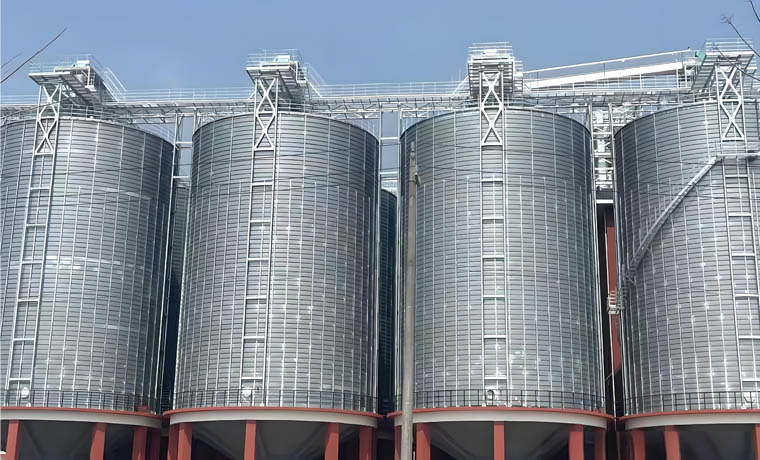In the field of grain storage, steel silo plays a crucial role as an efficient and economical storage equipment. With the advancement of technology and the development of material science, the design of grain steel silo is becoming more and more diversified to meet the storage needs of different kinds of grain.

Circular Silo
Round silo, is one of the most common types in grain storage. Its structural design is simple and clear, and its appearance is round and beautiful, which not only conforms to the principle of mechanics, but also has a good visual effect. The circular silo is mainly composed of a cylinder body, a bottom plate, a top cover and peripheral wall plates, with an internal support skeleton to enhance the stability and safety of the structure. This structural feature makes the round silo can withstand greater grain pressure, very suitable for storing rice, flour and other good mobility, higher density grain. In addition, the round silo is easy to realize mechanized operations, such as grain in and out of the silo, ventilation and air exchange, etc., greatly improving the storage efficiency and management level.
Rectangular Silo
Compared with the circular silo, the rectangular silo is closer to the rectangular shape, occupies a relatively small area and has a higher space utilization rate, which is especially suitable for storing granular grain such as soybeans and corn. While the design of rectangular silos improves land utilization efficiency, it also poses challenges in terms of construction difficulty, such as ensuring the verticality and sealing of the silo walls. Therefore, when constructing rectangular silos, it is necessary to strictly control the construction quality and use advanced construction techniques and materials to ensure the durability and safety of the silo.
Conical Silos
The conical silo, with its unique design of wide at the bottom and narrow at the top, has become an effective solution to the problem of uneven pressure distribution in grain storage. This design not only reduces the force on the bottom of the silo, but also optimizes the ventilation of the grain, which is especially suitable for wheat, rice and other grains that require good ventilation. The sloping walls of the conical silo also help the grain to slide down naturally, making it easier for the grain to exit the silo. However, the construction cost of conical silo is relatively high, and the requirements for foundation treatment are more stringent, need to be carefully selected according to the specific conditions.
Special types of grain steel silo
In addition to the above three basic types, grain steel silo has developed a variety of special types to meet the storage needs of specific environments. Insulation warehouse through the use of special insulation materials, effective control of temperature fluctuations in the warehouse, suitable for temperature-sensitive grain storage; anti-corrosion warehouse through the surface treatment technology or add anti-corrosion layer, improve the corrosion resistance of the warehouse body, to extend the service life, especially suitable for wet or corrosive environments; anti-insect warehouse through physical or chemical means to effectively prevent the invasion of pests, to protect the safety of grain storage. These special types of steel silos for grain and oil not only improve the quality of storage, but also broaden the scope of application of steel silos.
In the selection of grain steel silo, full consideration should be given to the characteristics of the stored materials, the conditions of the storage environment and the economic budget and other factors, through scientific and reasonable planning and design, to ensure that the selected silo type can meet the current demand, but also has a long-term applicability. With the continuous progress and innovation of technology, the future design of grain and oil steel silo will be more intelligent, green, and bring more efficient and safe solutions for the grain storage industry.
Leave a Reply